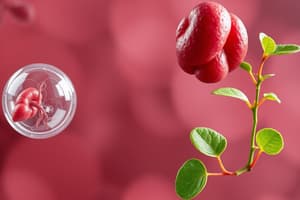Podcast
Questions and Answers
Which of the following statements regarding the electron transport chain in cellular respiration is FALSE?
Which of the following statements regarding the electron transport chain in cellular respiration is FALSE?
Which of the following statements accurately describes the relationship between photosynthesis and cellular respiration?
Which of the following statements accurately describes the relationship between photosynthesis and cellular respiration?
Which of the following statements best explains why enzymes are crucial for metabolic processes?
Which of the following statements best explains why enzymes are crucial for metabolic processes?
Which of the following conditions would NOT directly affect the rate of photosynthesis?
Which of the following conditions would NOT directly affect the rate of photosynthesis?
Signup and view all the answers
Which of the following statements best describes the role of ATP in both photosynthesis and cellular respiration?
Which of the following statements best describes the role of ATP in both photosynthesis and cellular respiration?
Signup and view all the answers
Which of the following statements most accurately describes the difference between aerobic and anaerobic respiration?
Which of the following statements most accurately describes the difference between aerobic and anaerobic respiration?
Signup and view all the answers
If an enzyme is exposed to a temperature significantly higher than its optimal temperature, what effect will this have on its activity?
If an enzyme is exposed to a temperature significantly higher than its optimal temperature, what effect will this have on its activity?
Signup and view all the answers
Which of the following statements best describes the role of chlorophyll in photosynthesis?
Which of the following statements best describes the role of chlorophyll in photosynthesis?
Signup and view all the answers
Study Notes
Cellular Respiration
- Cellular respiration is the process by which cells break down glucose to release energy in the form of ATP.
- It's an aerobic process, meaning it requires oxygen. Different types include aerobic and anaerobic respiration.
- Three main stages: glycolysis, the Krebs cycle, and the electron transport chain.
- Glycolysis occurs in the cytoplasm and does not require oxygen.
- Pyruvate, the product of glycolysis, is transported to the mitochondria.
- The Krebs cycle occurs within the mitochondrial matrix.
- The electron transport chain occurs on the inner mitochondrial membrane.
- ATP is produced through oxidative phosphorylation in the electron transport chain.
- Cellular respiration is crucial for providing energy to all cellular activities.
Photosynthesis
- Photosynthesis is the process by which plants and some other organisms use sunlight to synthesize foods from carbon dioxide and water.
- It's an endothermic process (requires energy).
- Two main stages: the light-dependent reactions and the light-independent reactions (Calvin cycle).
- The light-dependent reactions occur in the thylakoid membranes of chloroplasts and use light energy to produce ATP and NADPH.
- The light-independent reactions (Calvin cycle) occur in the stroma of chloroplasts and use ATP and NADPH to fix carbon dioxide and produce glucose.
- Chlorophyll plays a critical role in capturing light energy.
- Photosynthesis is crucial for producing oxygen and food for most ecosystems.
- Factors affecting photosynthesis include light intensity, carbon dioxide concentration, and temperature.
Enzymes
- Enzymes are biological catalysts that speed up chemical reactions in living organisms.
- They are typically proteins.
- Enzymes work by lowering the activation energy needed for a reaction to occur.
- The substrate binds to the enzyme's active site.
- The enzyme-substrate complex forms, and the reaction occurs.
- The products are released, and the enzyme is unchanged.
- Enzymes are specific to the reactions they catalyze.
- Factors affecting enzyme activity include temperature, pH, and substrate concentration.
- Denaturation can occur if enzymes are exposed to extreme temperatures or pH levels.
- Enzymes are essential for metabolic processes.
- Enzymes can be regulated and controlled.
- Coenzymes and cofactors can be important participants in the overall enzyme activity.
- Inhibitors can either competitively or non-competitively reduce the activity of enzymes.
- Examples include pepsin, amylase, and lipase.
Studying That Suits You
Use AI to generate personalized quizzes and flashcards to suit your learning preferences.
Description
This quiz covers the fundamental processes of cellular respiration and photosynthesis. It explores their stages, requirements, and significance in energy production and consumption. Understanding these processes is essential for studying biology and ecology.




